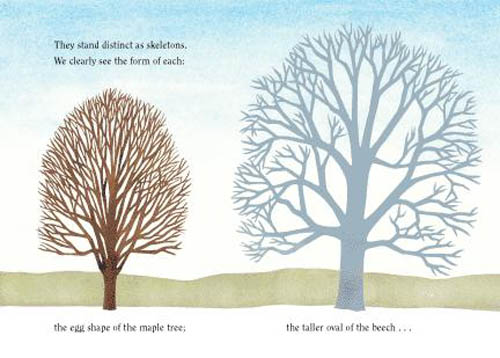I 've had this idea brewing in my mind for quite some time and have been waiting for the ideal time to try it with my students. Meanwhile, my assistant found this beautiful book and brought it to school:
As I leafed through the pages and read this gorgeously illustrated book, an idea came to me. I thought it would be meaningful to not only read this book to the children, but also use it as a starting point for a special winter nature walk. Along the way, we could compare trees we see in nature and those described in the book:
 |
| A page from Winter Trees by Carole Gerber; illustrated by Leslie Evans. |
As we walk, we can not only identify trees, but also collect bits and pieces of nature - pine cones, berries, cedar, spruce, and pine branch pieces... These treasures could then be assembled to create ice collages to be hung throughout our outdoor play areas (more on that part in another post).
The children were excited when I told them we would be taking a Winter Nature Walk. We bundled up, brought a couple of baskets, the book, and the camera...
 |
| First, we spotted the, "'V' formation of the birch." |
 |
| Then, we saw the, "egg shape of the maple tree." |
 |
| The beech tree whose, "tan leaves still cling to limbs and branches." |
 |
"...older needles near the trunk drop off and fall onto the ground."
(The kids had a blast clamoring for the needles...) |
 |
| "The hemlock lives for centuries. Look how huge this tree has grown!" |
Along the way, we enjoyed the sight of gently falling flakes and the sound of crunchy snow under our feet. We gathered our treasures in some baskets and eagerly filled them up!
 |
| Working together gathering nature's treasures. |
When we returned to the classroom, each child assembled the collected nature finds into ice collages - I'll share more about those in the next post! Stay tuned for more winter fun...























































